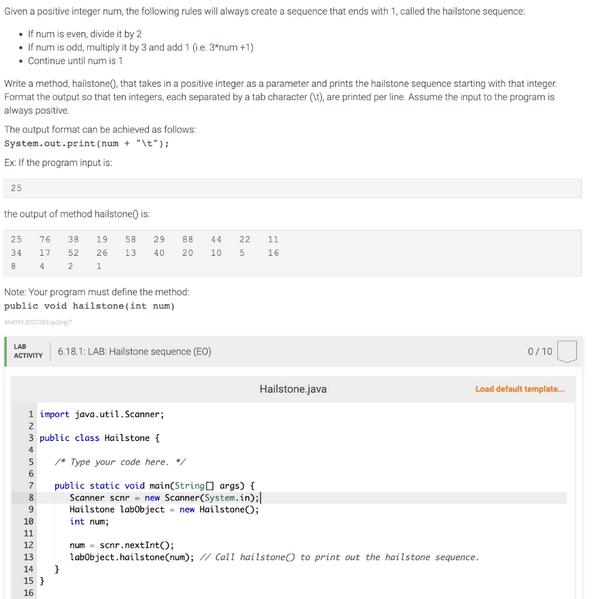Answered step by step
Verified Expert Solution
Question
1 Approved Answer
Given a positive integer num, the following rules will always create a sequence that ends with 1, called the hailstone sequence: If num is

Given a positive integer num, the following rules will always create a sequence that ends with 1, called the hailstone sequence: If num is even, divide it by 2 If num is odd, multiply it by 3 and add 1 (ie. 3*num +1) Continue until num is 1 Write a method, hailstone(), that takes in a positive integer as a parameter and prints the hailstone sequence starting with that integer. Format the output so that ten integers, each separated by a tab character (\t), are printed per line. Assume the input to the program is always positive. The output format can be achieved as follows: System.out.print (num + "\t"); Ex: If the program input is: 25 the output of method hailstone() is 25 34 8 Note: Your program must define the method: public void hailstone(int num) LAB ACTIVITY 5 6 7 8 9 18 1 2 3 H15 16 1 import java.util.Scanner; 2 3 public class Hailstone { 4 10 76 38 17 52 26 13 40 4 2 1 11 12 13 19 58 29 88 20 15} 6.18.1: LAB. Hailstone sequence (EO) /Type your code here. / 14 } 44 10 N 22 5 public static void main(String[] args) { Scanner scnr = new Scanner(System.in); Hailstone labObject new Hailstone(); int num; 11 16 Hailstone.java 0/10 Load default template.... num scnr.nextInt(); labObject.hailstone(num); // Call hailstone() to print out the hailstone sequence.
Step by Step Solution
There are 3 Steps involved in it
Step: 1
Hailstonejava import javautilScanner public class Hailstone public void hailstonei...
Get Instant Access to Expert-Tailored Solutions
See step-by-step solutions with expert insights and AI powered tools for academic success
Step: 2

Step: 3

Ace Your Homework with AI
Get the answers you need in no time with our AI-driven, step-by-step assistance
Get Started


